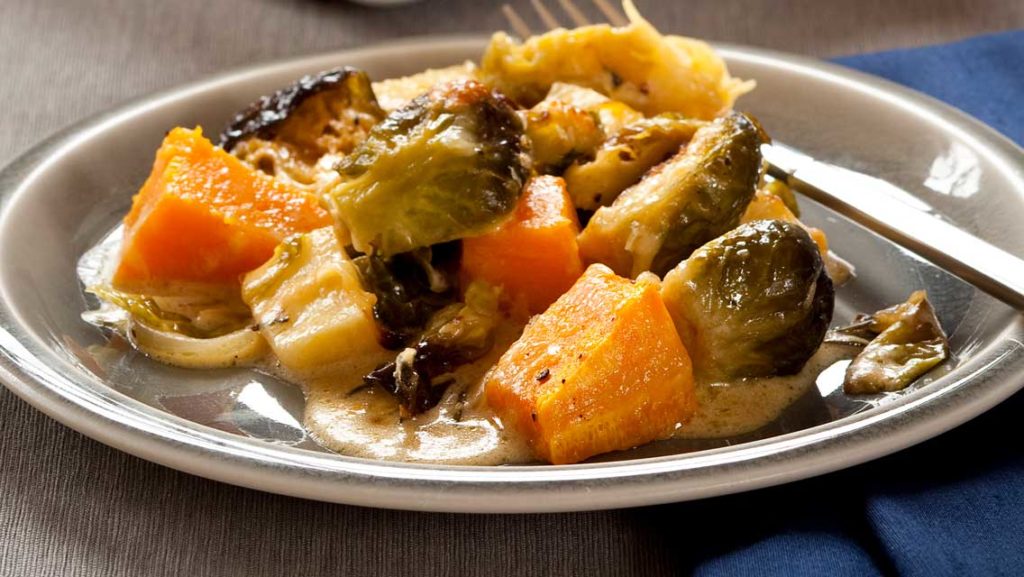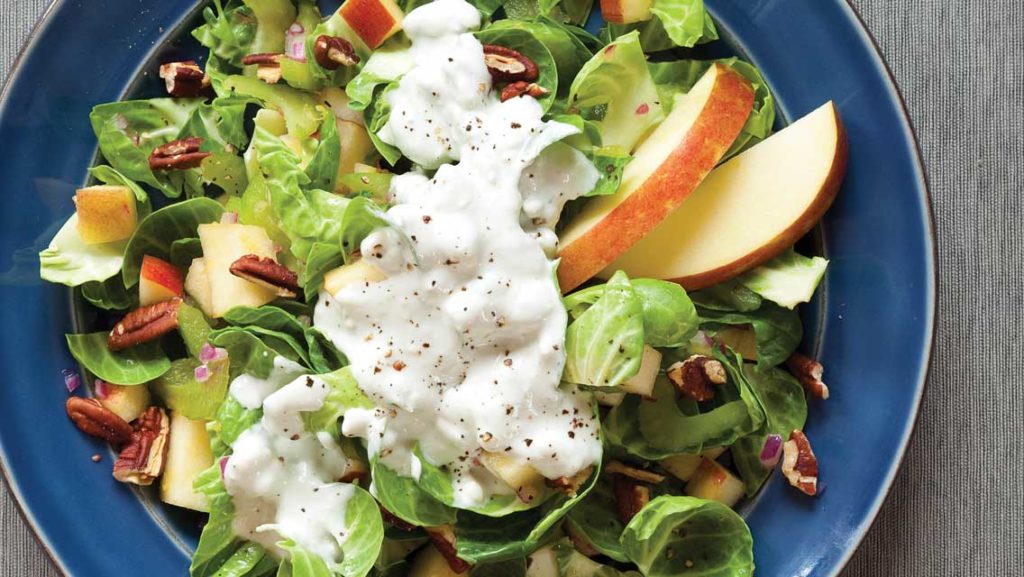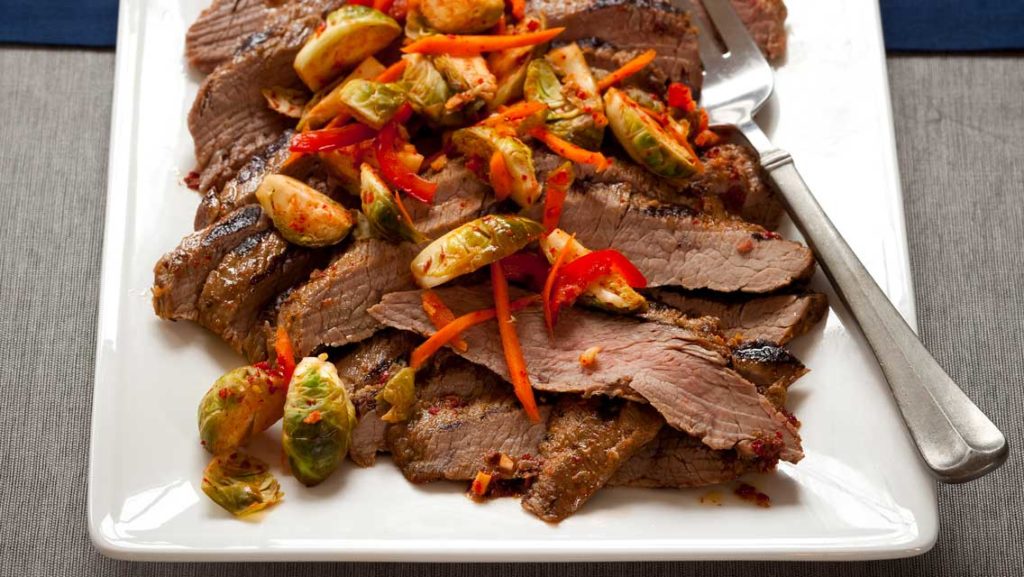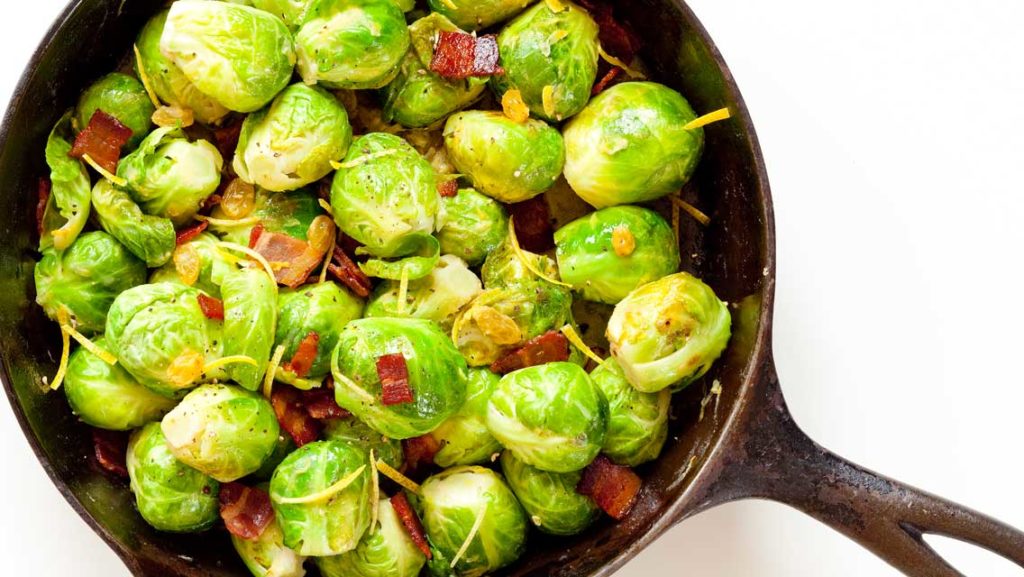Once universally, and in some cases justifiably, despised, Brussels sprouts are finally getting their due. Open up any trendy restaurant menu, and you are almost guaranteed to see a plate of succulent, roasted Brussels sprouts offered as a starter course. Unlike the bland, sogged-out sprouts of our youth, these tasty treats are often gussied up with salty bacon, sweet balsamic vinegar, or nutty Parmesan. When overcooked, Brussels sprouts stink of sulfur and turn to mush. When fresh and prepared well, however, these healthy little brassicas — related to broccoli, cauliflower, and kale — are simply glorious. From sage green to slightly red, Brussels sprouts look like mini cabbages and are generally harvested in the fall. The smaller the sprouts, the more tender they are — and they are even more tender and sweet after a frost. So enjoy the cooler weather with a warm dish of autumn jewels. In the next few pages, you’ll find out just how easy they are to prepare.
Nutritional Know-How
- Brussels sprouts, part of the Brassica family, contain a unique combination of cancer-fighting phytonutrients called glucosinates, making it an important food for chronic disease prevention.
- High in fiber, Brussels sprouts are great for the digestive tract. They help reduce cholesterol and may reduce the risk of colon cancer.
- The nutrients in Brussels sprouts offer a powerful mix of cardiovascular, detox, antioxidant, and anti-inflammatory support.
Kitchen Tricks
- Just before cooking, wash well under running water.
- When you clean and trim Brussels sprouts, the outer leaves will come off easily. If you’re making a recipe for whole or halved sprouts, save these leaves for a salad.
- Brussels sprouts have thin leaves and a thick base. To help whole sprouts cook evenly, slice off the stem so you end up with a rounded head. Then cut an x in the thick base so heat can penetrate.
Shopping and Storage Tips
- Select Brussels sprouts that are firm and compact, with a vivid green color and no yellowed or wilted leaves.
- Whenever possible, choose sprouts that are grown locally. In season, you can often purchase them still attached to a tall stem.
- Store unwashed Brussels sprouts in an airtight container for up to 10 days. After that, they start to get bitter quickly.
- If you want to freeze Brussels sprouts, blanch them first for three to five minutes. You can keep them in the freezer for up to a year.
Autumn Vegetable Gratin
This creamy gratin is filled with colorful seasonal veggies. For a nice crunch, top with chopped toasted walnuts before serving.

Makes | six to eight servings
Ingredients
- 1 cup each peeled and cubed winter squash, parsnips, and celery root
- 3 cups trimmed and halved Brussels sprouts
- 1/2 yellow onion, very thinly sliced
- 1 tbs. extra-virgin olive oil
- Salt and freshly ground black pepper to taste
- 1 tsp. minced fresh rosemary
- 1/2 cup heavy cream, coconut milk, or unsweetened hemp-seed milk
- 1 cup vegetable broth
- 1 tsp. potato starch
- 3/4 cup shredded Gruyère cheese, divided
Directions
- Heat oven to 400 degrees F.
- Toss the vegetables with the olive oil, salt, and pepper, and roast in a 11/2-quart roasting pan, stirring occasionally, for 30 minutes. Transfer the veggies to a gratin dish.
- While the vegetables roast, prepare the gratin sauce by heating the rosemary, cream, and broth together. Mix the potato starch with 1/2 cup water until smooth and stir into the simmering cream and broth. Whisk over low heat until thickened.
- Stir in 1/2 cup of the cheese until melted and pour the sauce over the vegetables, stirring to coat.
- Sprinkle the gratin with the remaining cheese and bake until it’s golden and bubbly, 20 to 25 minutes.
Brussels Sprouts and Apple Salad
This recipe is terrific with a variety of other dressings, including raspberry vinaigrette. To save on preparation time, you can thinly slice or shred the sprouts in a food processor instead of pulling apart individual leaves.

Makes | four servings
Ingredients
- 1 cup diced apple
- Juice and zest of one lemon
- 1 cup thinly sliced celery (about three stalks)
- 1/4 cup minced red onion
- 6 cups Brussels sprouts leaves, loosely packed
- 1/2 cup roasted pecans, chopped
- 1/2 cup sour cream or full-fat plain Greek yogurt
- 2 tbs. apple-cider vinegar
- 1/4 cup crumbled blue cheese
- Salt and freshly ground black pepper to taste
Directions
- In a large mixing bowl, toss the apples with the lemon juice and zest. Add the celery, onions, and Brussels sprouts leaves.
- Divide salad equally on four plates and sprinkle each with roasted pecans.
- Mix together the sour cream, apple-cider vinegar, blue cheese, and salt and pepper.
- Dress each salad and serve.
Brussels Sprouts Kimchi With Peppers and Carrots
Traditionally made with cabbage or bok choy, the Korean dish kimchi is also a great vehicle for Brussels sprouts. This recipe takes a little time but is well worth the effort. Kimchi is wonderful served with meat, eggs, vegetables, and rice. (For a quicker kimchi recipe, see the Web Extra below.)

Makes | 4 cups
Ingredients
- 4 tbs. kosher salt
- 4 cups water
- 1 pound quartered or halved Brussels sprouts
- 1 1/2 tbs. Korean red chili flakes or crushed red chili flakes
- 1 tbs. fish sauce or anchovy sauce
- 1 tsp. sugar
- 1 tsp. minced garlic
- 1 tsp. finely grated ginger
- 1/2 cup julienned carrot
- 2 green onions, thinly sliced (green parts only)
- 1/4 cup julienned red bell pepper
Directions
- Dissolve the salt in the water; add the Brussels sprouts and soak for 45 minutes. Drain and rinse the sprouts.
- Meanwhile, mix the chili flakes, fish or anchovy sauce, sugar, garlic, and ginger together. Toss the mixture with the carrots, green onions, red peppers, and sprouts.
- Tightly pack the vegetables into a 1-quart canning jar or other container with a tight-fitting lid. Leave at room temperature for 24 hours, shaking the jar occasionally to distribute the marinade.
- Store in the refrigerator and consume within one month.
WEBEXTRA
Quick Brussels-Sprouts Kimchi
This sped-up preparation of kimchi can be eaten immediately or stored for up to a month.

Makes | about 2 cups
- 4 cups shredded Brussels sprouts
- 5 green onions, sliced long and thin on the bias
- 2 tbs. Korean chili pepper flakes or crushed red chili flakes
- 1/2 tsp. minced garlic
- 1 tsp. minced gingerroot
- 1 tsp. sugar
- 1 tbs. fish sauce or anchovy sauce
Directions
- Toss the shredded Brussels sprouts and green onions with the salt and allow to sit for 20 minutes.
- Meanwhile, mix the remaining ingredients in a small bowl. After 20 minutes, rinse the sprouts and onions well and drain well; then, combine with the spice mixture. The kimchi is now ready to eat. If you would like to age it a bit, place the mixture in a tightly sealed canning jar and allow to sit overnight at room temperature.
- Store in the refrigerator and consume within one month.
Bacon-Braised Brussels Sprouts
Bacon and Brussels sprouts is a natural pairing, but if you are a vegetarian, try a vegetarian tempeh bacon or just add a little smoked Spanish paprika.

Serves | four to six
Ingredients
- 1/4 cup golden raisins
- 1/4 cup dry sherry or apple juice
- 2 tbs. Dijon mustard
- Juice and zest of one lemon
- 4 slices nitrate-free bacon, cut into 1/4-inch pieces
- 1 1/2 pounds of Brussels sprouts, trimmed and tough outer leaves removed
- Salt and freshly ground black pepper to taste
Directions
- Soak the raisins in the sherry and set aside.
- Whisk together the mustard with lemon juice and set aside.
- Add the bacon pieces to a heavy cold skillet and then heat the pan so that the fat from the bacon can slowly render out. Cook the bacon over low-to-medium heat and allow it to crisp. Remove the bacon pieces from the fat and set aside. (If the bacon was very fatty, remove all but two two tablespoons of the bacon fat.)
- Add the Brussels sprouts to the bacon fat and sauté until the sprouts begin to brown on the sides, stirring frequently.
- Add the sherry and raisins and then season with salt and pepper. Cover the sprouts and cook over low heat for about five to eight minutes until they are just tender.
- Stir in the bacon and reserved lemon zest, and serve the sprouts with a drizzle of the lemon-mustard sauce.
The Puff Pastry of Vegetables
“Brussels sprouts — Birds Eye frozen, thank you very much — were on my most-hated-vegetables list as a kid,” says chef, restaurateur, and cookbook author Suzanne Goin. “They were always overcooked, mushy, and maybe I had not yet discovered my love of their slight bitterness. I remember thinking, How can such a cute little cabbage be so gross?” Today, however, Goin — celebrated founder of the Los Angeles restaurants Lucques, A.O.C., Tavern, The Larder at Maple Drive, and The Larder at Burton Way — adores Brussels sprouts. Her most recent book, The A.O.C. Cookbook (Random House, 2013), includes one of her favorite recipes, Balsamic-Glazed Brussels Sprouts With Pancetta. She talked with us about her new favorite veggie.
Describe Brussels sprouts’ flavor.
Slightly bitter, delightfully earthy. I probably appreciate the texture as much as the flavor. When properly prepared, they have a bit of crush from all those lovely layers — they’re almost like the puff pastry of vegetables.
What would you say to someone who is nervous about cooking them?
They are so easy. It’s really all about getting a nice sear and then not overcooking them. It’s funny, my business partner just said she has always been afraid to cook them, and the other day she sautéed them as [described] in my book and was surprised that they cooked that fast and on top of the stove without having to go in the oven.
What are some common mistakes people make when cooking them?
Boiling or steaming them is a mistake. And overcooking them — this is when the mush factor comes in.
What are your tips for successfully cooking Brussels sprouts?
Like so many foods, Brussels sprouts are better when they have a nice sear that brings out their sweeter notes and also creates a contrast between the soft interior and the crispy exterior. And seasoning is key. Just seasoning with salt and pepper works wonders. I love balsamic vinegar with them, too, because it counters the bitterness nicely.
What other flavors do you love to pair with Brussels sprouts?
They actually work well with anything sweet, and combined with winter squash, chestnuts, parsnips, or carrots, as well as meats with sweet and gamy notes, such as pork and duck.
What is your favorite way to eat Brussels sprouts?
My favorite way used to be sautéed with garlic, onion, and pancetta, and then pan-braised with a splash of balsamic and veal stock, as in my A.O.C. Cookbook recipe. This season I’ve been just sautéing them with olive oil, shallots, garlic, and thyme, and finishing with a little balsamic. At A.O.C. we then toss them with sliced radicchio and long-cooked cavolo nero [also known as Tuscan or dinosaur kale] and stuff it all into a sandwich with
burrata cheese.
What do you make of the fact that Brussels sprouts, once universally despised, have become so trendy?
I always find it surprising that vegetables that have been around for thousands of years suddenly become trendy. It’s really weird to me. I have been cooking Brussels sprouts for 20 years, so it has never been a trend to me. The downside of being trendy is that after a while, people think a vegetable is out of style and forget it’s just a delicious vegetable.
I like to remind people that being “cool” isn’t the veggie’s fault — look at poor kale, which is now considered “played out”!




This Post Has 0 Comments